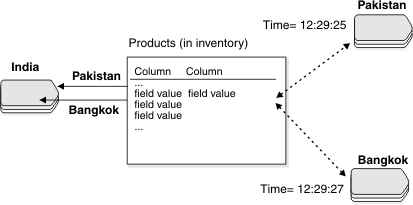Applying replicated data
Informix® Enterprise Replication uses a data-synchronization process to apply the replicated data to target database servers.
The target database servers acknowledge receipt of data when the data is applied to the target database. Data modifications that results from synchronization, including modifications that result from trigger invocation, are not replicated. The data-synchronization process ensures that transactions are applied at the target database servers in an order equivalent to the order that they were committed on the source database server. If consistency can be preserved, Enterprise Replication might commit transactions out of order on the target database.
When Enterprise Replication applies replication data, it checks to make sure that no collisions exist. A collision occurs when two database servers update the same data simultaneously. Enterprise Replication reviews the data one row at a time to detect a collision.

The previous illustration shows a situation that yields a conflict. Pakistan updates the row two seconds before Bangkok updates the same row. The Bangkok update arrives at the India site first, and the Pakistan update follows. The Pakistan time is earlier than the Bangkok time. Because both updates involve the same data and a time discrepancy exists, Enterprise Replication detects a collision.
For more information, see Conflict Resolution.
- A replicated DELETE that finds no row to DELETE on the target
- An UPDATE that finds no row to UPDATE on the target
- An INSERT that finds a row that exists on the target